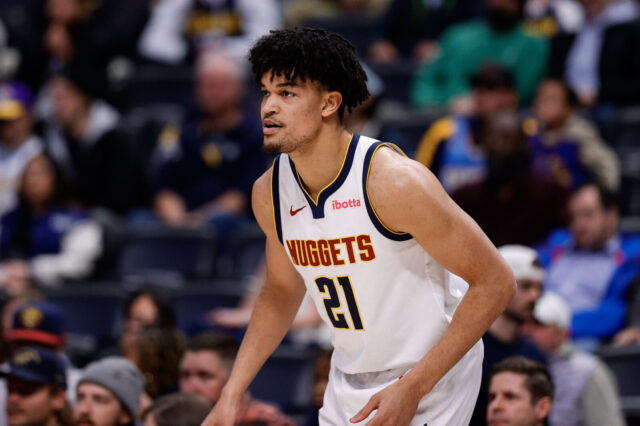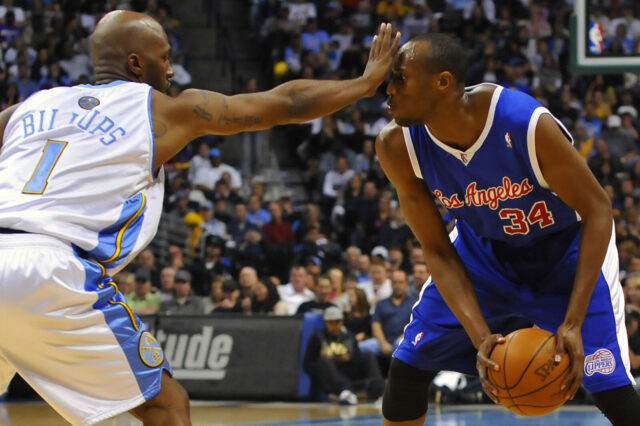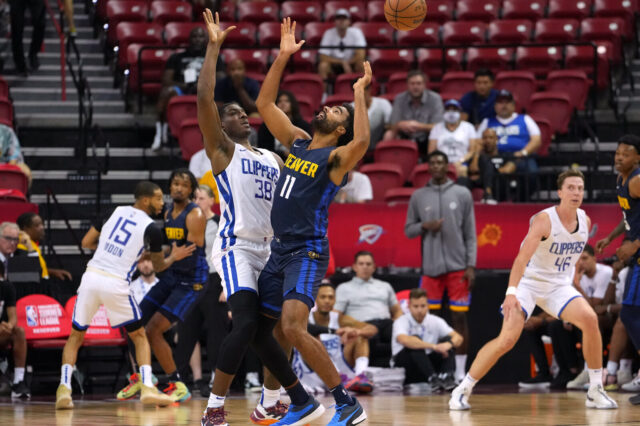Today’s Stat of the Week will focus on a number of problems centered around the Nuggets’ defensive numbers, metrics, rotations and schemes, highlighted by a distinct dysfunction surrounding that end of the floor. Nikola Jokic has been made a scapegoat of these defensive issues by local and national media, but the problems move much further than Denver’s immobile center.
So much has been made of the offense in Denver since Paul Millsap returned to the team. After a monstrous February from an offensive standpoint, the Nuggets have struggled to fully incorporate all parties into the offensive flow thus far.
However, the biggest story during Denver’s three seasons under Michael Malone in my opinion remains the defense and Denver’s lack of improvement over the last three years on that end of the floor.
This content is no longer available.
Now, some may look at the title of that chart and say: “wow, this Michael Malone guy doesn’t know what he’s talking about.” I can assure you that this is entirely false. Having been endorsed by LeBron James, Stephen Curry, Gregg Popovich, and others on his abilities as a coach and the schemes he operates, it would be crazy to question Malone in this regard. Coming in, Malone’s reputation was as a defensive coach, and to have so many ringing endorsements from players and coaches that know the game so well gives him the benefit of the doubt.
The numbers speak differently though, and there are three main factors surrounding Denver’s inability to defend at a high level:
- Difficult personnel to craft schemes around
- Overcompensation for Nikola Jokic’s deficiencies
- Age/Inexperience
Let’s face it, Nikola Jokic is a difficult player to build around. He’s slow, he’s immobile at times, and he has dealt with a variety of issues related to effort and conditioning over the past three years. Some of that is due to his young age and the natural conditioning process of an NBA player, but it’s hard to see how he becomes quick enough to consistently stick with the athletic players of today’s NBA.
However, there’s data that says that Jokic isn’t the entire problem defensively. Take a much better athlete in Mason Plumlee for example, or a more natural defender in Jusuf Nurkic back during the 2015-16 and 2016-17 seasons. Neither of them have made a discernible impact on Denver’s defensive numbers any more than Jokic has:
This content is no longer available.
There are caveats for these ratings of course. Jokic has played the majority of each season with the starters, who are most often the best defensive players in Malone’s rotation. Gary Harris, Wilson Chandler, even Paul Millsap to a degree have spent the most time with him this season. Still, it would make the most sense for a hypothetically better defender to be inserted and generate better defensive results, but that just isn’t true for most of Denver’s numbers.
Here are each big’s defensive ratings when on the floor in lineups featuring Harris and Chandler:
This content is no longer available.
The point being, Jokic isn’t the sole reason for Denver’s defensive issues this season or any other season. It doesn’t make him a good defender. It doesn’t make him NOT a BAD defender either. Those are the facts though, plain and simple.
So then, what is the problem?
As I listed above, I have three reasons: personnel, overcompensation, and age.
Let’s start with personnel. Most people point to Jokic in this regard, and they are partially right. Jokic is no Rudy Gobert at the rim. He’s probably closer to a revolving door at The Marriott in terms of resistance (though those doors can get stuck in the wind). Still, Denver has other issues, and they were exasperated by Paul Millsap’s extremely long hiatus.
Jamal Murray is not a good defender. He tries hard, but on top of being young and inexperienced, he doesn’t have the physical gifts to be an elite defender. When Murray is on the floor, the Nuggets allow a 109.5 defensive rating. When he’s off the floor, that number drops to an even 107. Murray doesn’t have the length or agility to contest this simple drive from Damian Lillard and fouls him in the process.
Gary Harris is similarly sized to Murray, and while he has much better instincts and a knack for that side of the floor, he wasn’t blessed with the height or reach to truly contest some shots. There will always be issues for him in contesting taller wings or switching onto bigger players in general. Most top defenses in the NBA have a shooting guard that is 6’6 or taller, from Boston’s Jaylen Brown, to San Antonio’s Danny Green, to Toronto’s DeMar DeRozan, to Golden State’s Klay Thompson. Not all of those guys are elite defenders, but they do have enough height to switch and be versatile in their coverages. Gary Harris can only guard most point guards and shooting guards on a consistent basis.
Wilson Chandler is a solid individual and team defender, but he’s aging and has multiple hip surgeries under his belt. He doesn’t have the quick twitch he utilized during his early Denver years.
Will Barton struggles to stay in front of players to his frame and willingness to play defense for the whole game.
Malik Beasley is inexperienced and struggles to lock in and understand the intricacies of the defensive end.
Trey Lyles is still young and struggles to recognize certain play calls, and he doesn’t project to get much better at that.
Mason Plumlee has a negative wingspan and can be baited into going for blocks pretty easily.
Sighs
Basically, the personnel is bad. The skill is there offensively, and these guys love to play offense, but they struggle to lock in defensively individually, and that causes team defense breakdowns.
But the one thing that can be controlled is how to deploy these players and maximize them to the best of their abilities, even if their abilities don’t amount to a top tier defense right now. This is involved in the scheming, and I don’t think the Nuggets have done a great job of that.
Every time the Nuggets are guarding a pick and roll, and Nikola Jokic’s man is being used as the roll guy, the Nuggets use their other four players to cover for Jokic as much as possible.
Take the very first possession against the Cleveland Cavaliers last Wednesday night. Millsap and Jokic are covering a LeBron James and Larry Nance pick and roll.
This content is no longer available.
Harris wants to help Jokic out, and the scheme design calls for Harris to come into the lane and tag the roll man. Only on the first possession of the darn game, LeBron already knows this, and he’s already passing while Harris has two feet in the lane.
This content is no longer available.
By the time Harris recognizes the pass, the ball has pretty much passed him, and he’s still in the paint when J.R. Smith catches and is ready to fire. J.R. hits the shot, the Cavs are up 3 to 0, and the tone has been set for the first quarter.
This content is no longer available.
Jokic’s poor defense is one of the reasons this happens. Malone has decided that the best way to cover for Jokic’s deficiencies is to send more help to the paint. It’s very clear that Malone would rather give up a wide open three than a reasonably wide open two at the rim.
Another reason why it happens is because of the defense at the point of attack. Denver’s guards (and sometimes forwards) struggle with the opposing team’s pick and roll. Because of this, Malone shifts the roll man defender to provide more help and shifts the weak side defender(s) to provide help for the roll man. This concept works if the weak side defenders are 6’7 with a 7’0 wingspan and can fly around the perimeter, but Denver just doesn’t have those guys.
Here are the play type numbers to back this up:
This content is no longer available.
The frequency represents how often an opposing team finishes a possession with a certain type of field goal attempt. The one above by J.R. Smith is considered a spot up, and it’s Denver’s worst category. Opposing teams take spot up attempts the 10th most frequently against Denver, and Denver gives up 1.06 points per possession on those attempts, good for 29th, or second worst, in the NBA.
That’s not the end of Denver’s problems though. Even though Denver usually puts 1.5 players on the ball in pick and roll situations, that handler posts a 0.89 ppp.
Here’s the thing though, a 0.89 ppp, even though it’s the 5th worst mark in the NBA, is far less valuable than an open spot up attempt statistically. Good teams prevent those types of shots as much as they can. The bottom seven teams in frequency of spot up attempts by the opposition feature the 23rd, 8th, 7th, 4th, 5th, 16th, and 1st best defensive teams in the NBA as ranked by defensive rating. The only ones that aren’t are the Brooklyn Nets, who are extremely well coached by Kenny Atkinson, and the New Orleans Pelicans, who are doing enough to support their 7th best offensive rating anyway.
Why do the Nuggets continue to tag the roll man? It’s why the Houston Rockets continue to pick them apart. It’s why LeBron James has figured them out. Great cross-court passers see the Nuggets rotating, and they make excellent passes to play the numbers game against the Nuggets.
This is a failing of the scheme. It’s a well-documented one by members of our writing staff, and while the Nuggets personnel doesn’t help matters, the scheme calls to put Gary Harris in that compromising position above, and that’s a failing of coaching. Regardless of whether the players are executing the scheme right, the coaching staff should know by now that the Nuggets don’t have the personnel to satisfy these requirements. Unfortunately, this has been a staple of Denver’s for all three seasons.
It doesn’t seem like there have been changes in this regard, and that’s a major issue.
Lastly though, the Nuggets, coach and players alike, are still young relative to the rest of the league. This is Malone’s 4th full year, and in every season, he has improved as a coach. There are still issues with managing timeouts and the above scheming issues, but beyond that, he has done well to adjust offensively to a crazy weird talent in Jokic and let him and other young players run with things.
It’s a simple fact that top defenses are rarely full of youth. It takes game changing talent on the defensive end to make that work. Among the top 10 defenses, only the Celtics and the Sixers can be considered truly young (though the Jazz have a couple of great, young pieces). They are saved by Joel Embiid, perennial Defensive Player of the Year candidate, and Al Horford, a newcomer to the DPOY race. Jokic will likely never be that, but Marc Gasol once won the DPOY award, and this was a picture of him at one point in his life:
This content is no longer available.
Eventually, Nikola Jokic will grow up. Gary Harris will grow up. Jamal Murray will grow up. Who those players are now is not what they will be at 25, 27, 30, or 33. There’s plenty of time for them to correct some deficiencies, and while Jokic won’t be winning any dunk contests or sprints any time soon, he will get smarter, stronger, and more mentally stable from game-to-game.
The same can be said for Michael Malone. He will continue to improve, though I have concerns about his principles and the likelihood of evolution. The improvement in defense isn’t going to happen this season, but if Malone wants to regain his reputation as a defensive mind, he has to crack the puzzle of putting a good defense around Nikola Jokic. It cannot be in spite of him. It has to be because of him. If Malone cannot crack it without inserting another center, then it’s hard to see a future for all parties.
This content is no longer available.


